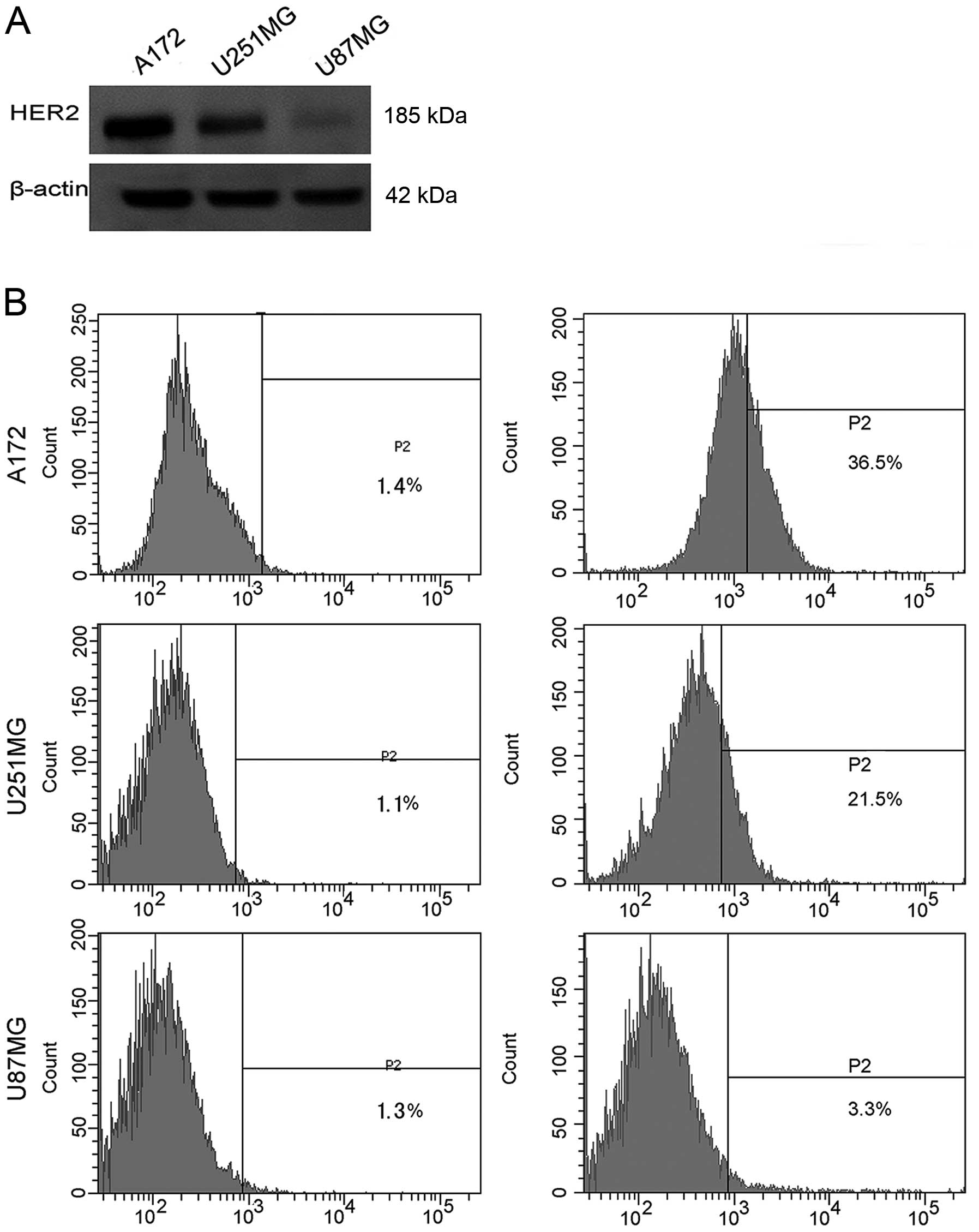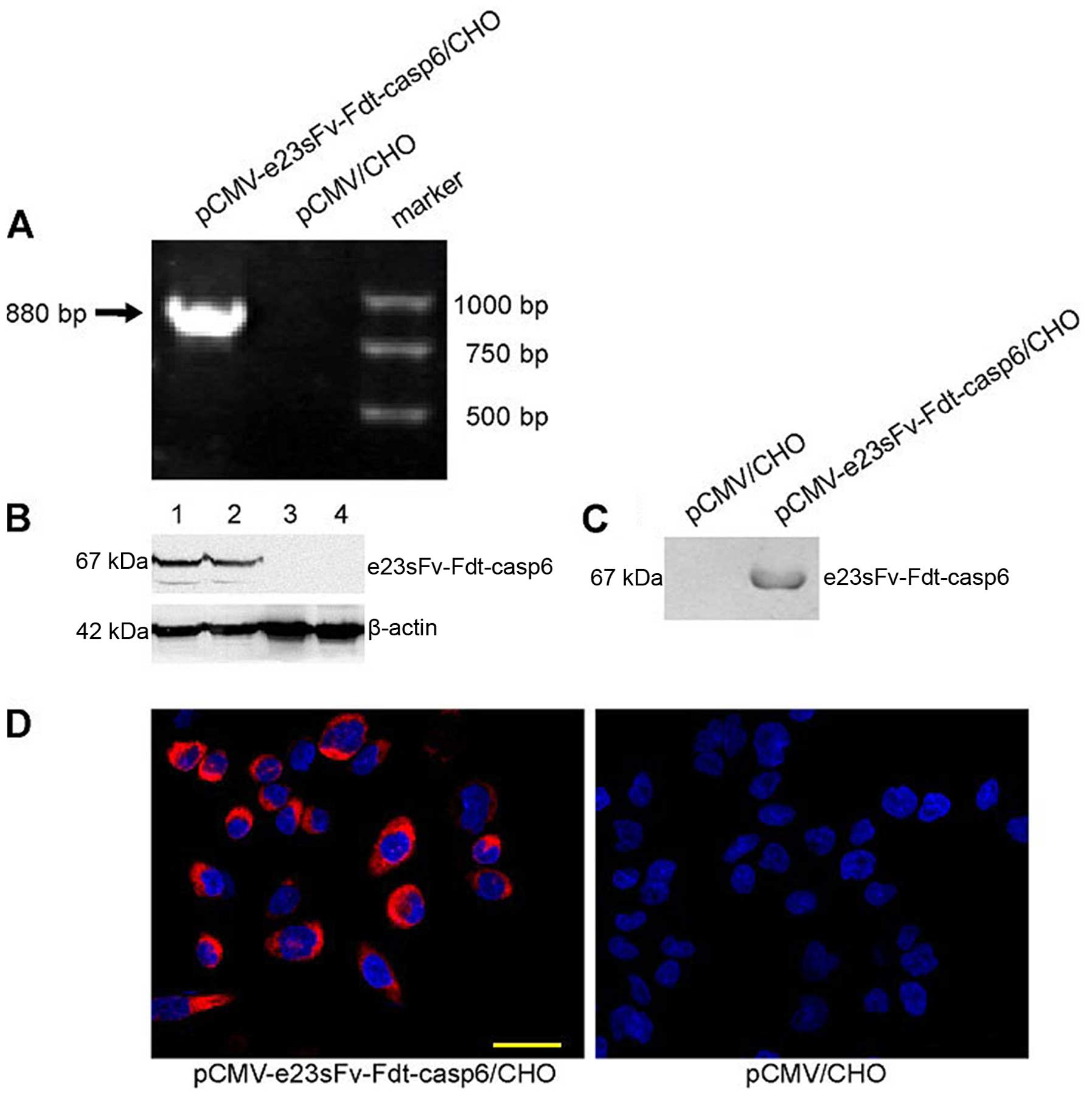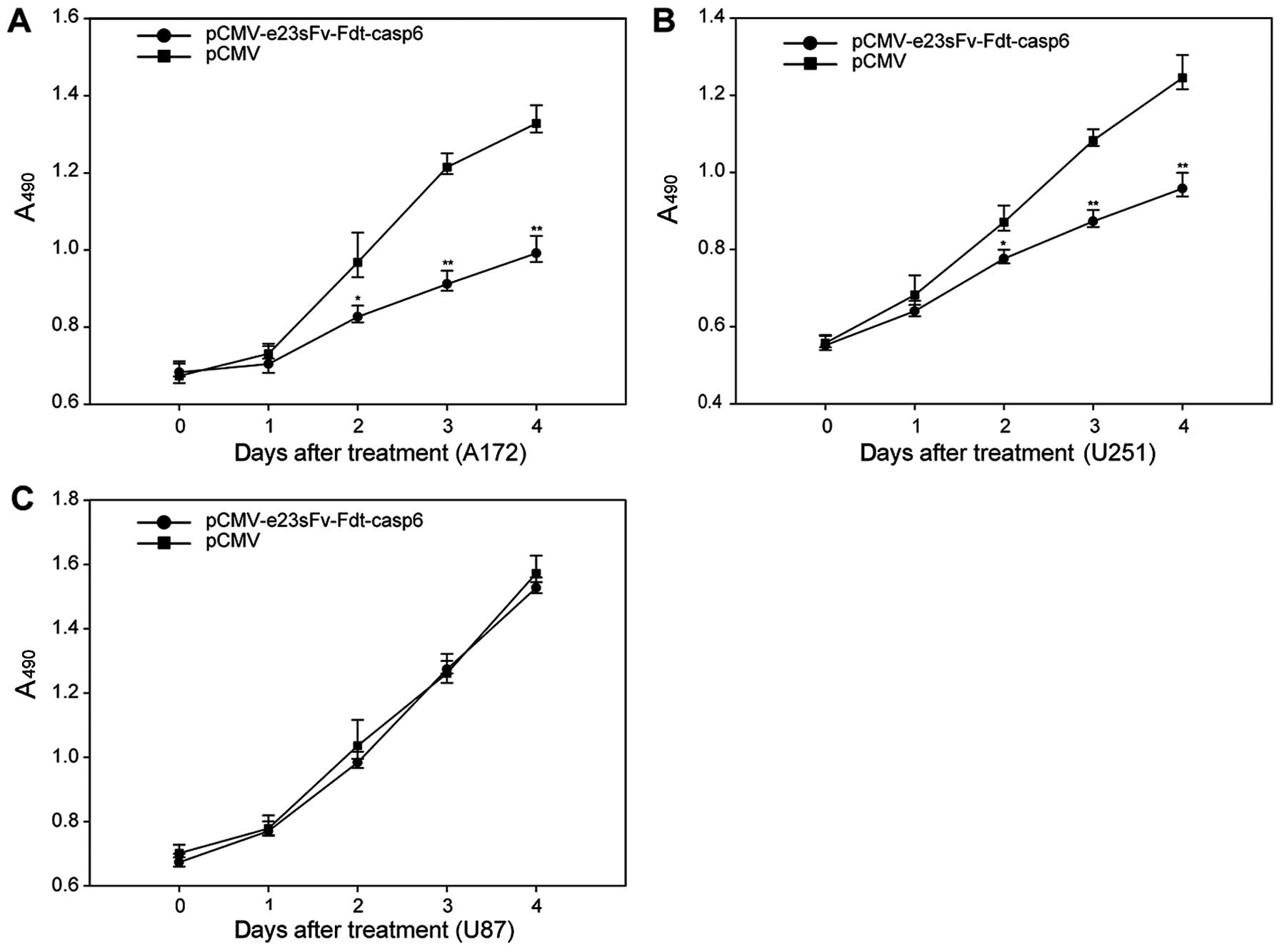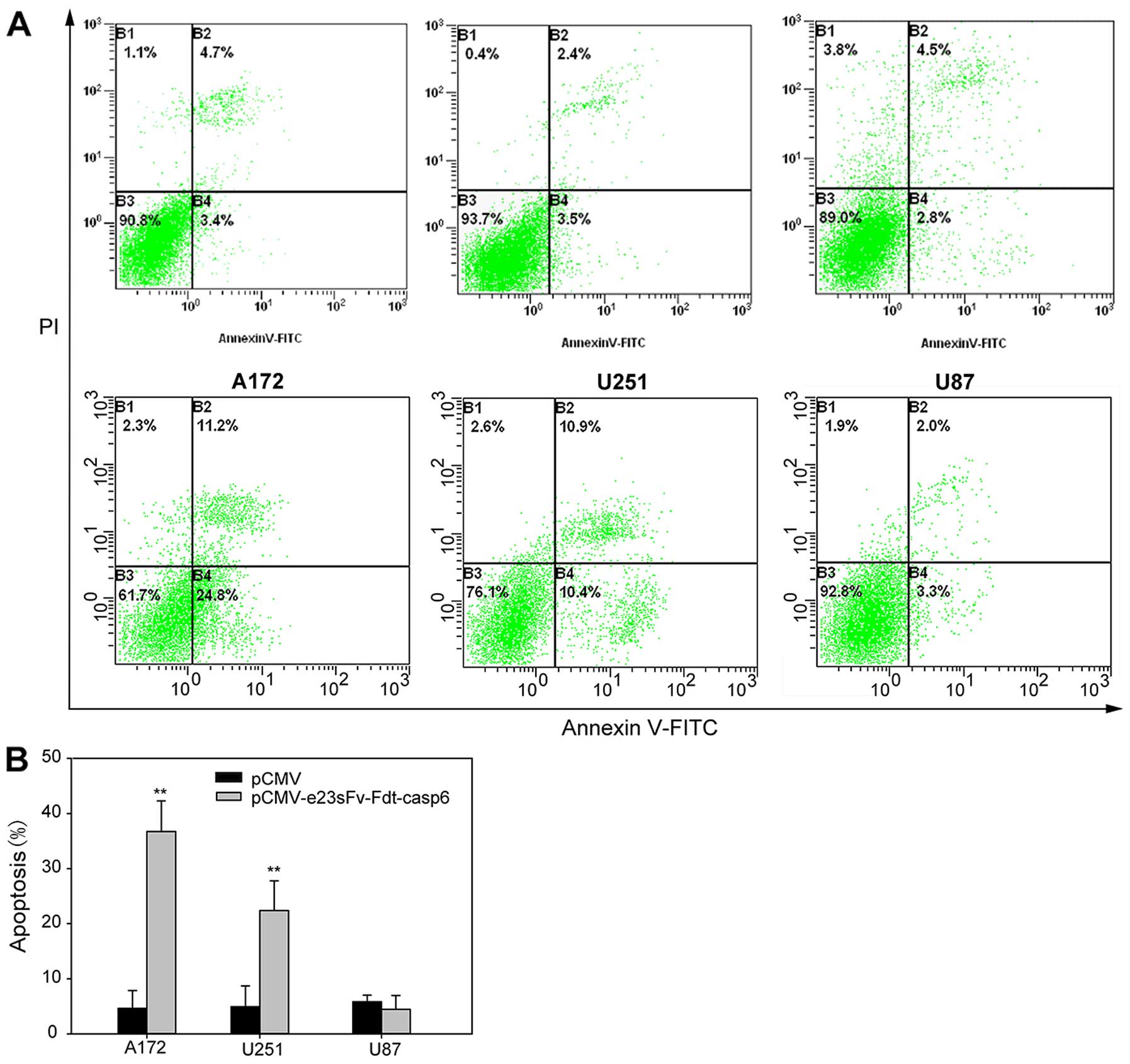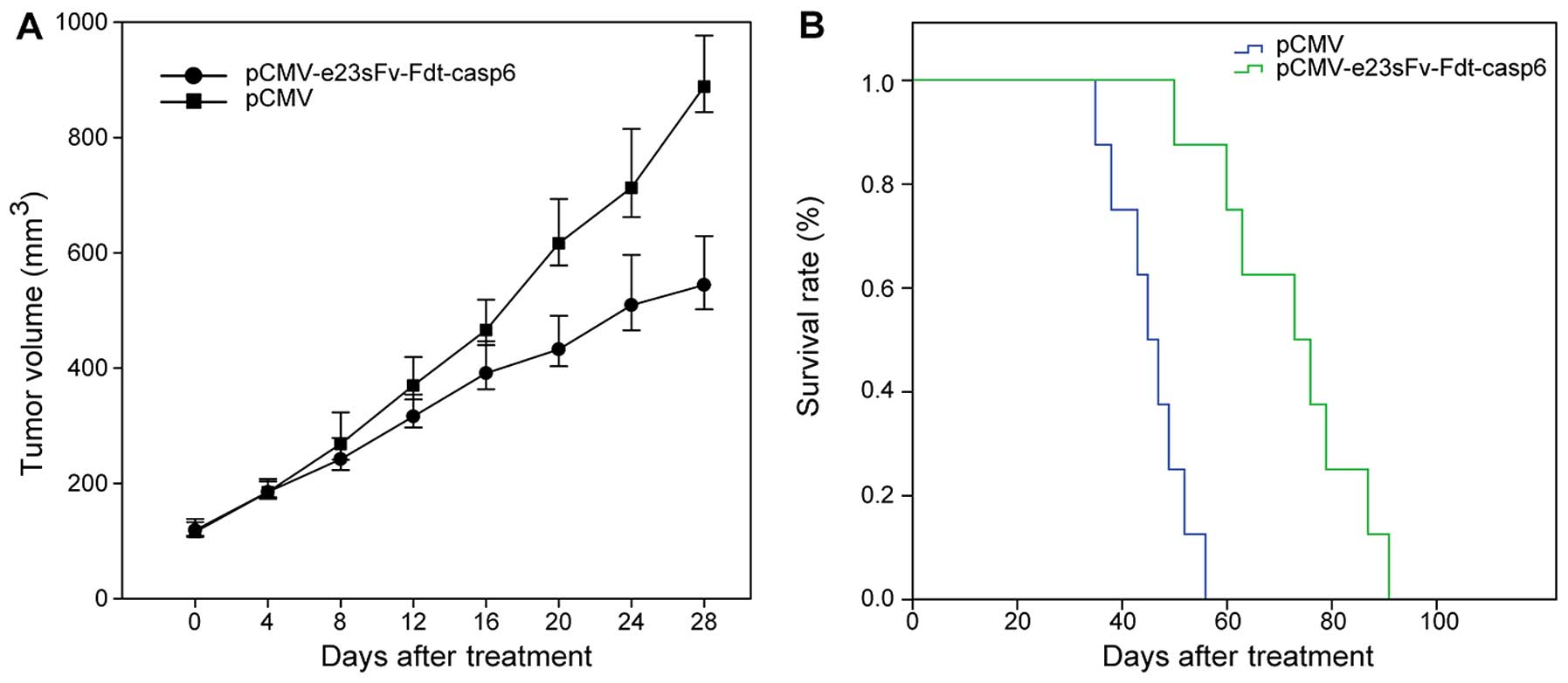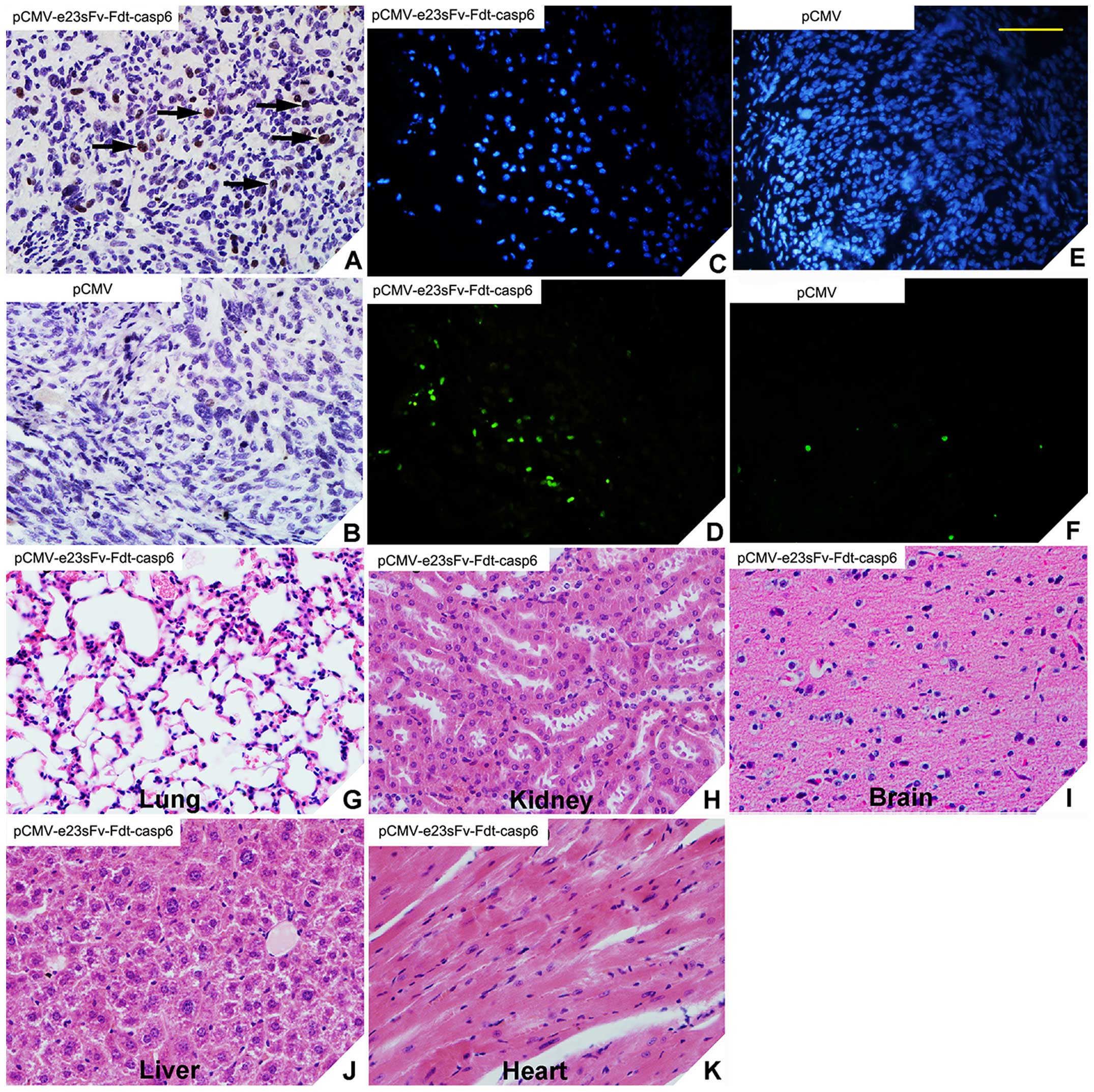HER2-targeted recombinant protein immuno-caspase-6 effectively induces apoptosis in HER2-overexpressing GBM cells in vitro and in vivo
- Authors:
- Published online on: September 12, 2016 https://doi.org/10.3892/or.2016.5088
- Pages: 2689-2696
Abstract
Introduction
Glioblastoma multiforme (GBM) is the most frequently encountered primary central nervous system neoplasm in adults, and is associated with high morbidity and mortality. Despite multimodal treatment options, including surgical resection, radiotherapy, and chemotherapy, the median survival of patients with glioblastoma is 12–15 months and 2–5 years for patients with anaplastic gliomas (1). GBM arises as a result of various genetic alterations and the deregulation of growth-factor signaling pathways, resulting in abnormal cellular proliferation, malignant differentiation, and increased invasiveness of malignant cells (2,3).
Human epidermal growth factor receptor 2 (HER2) is a cell membrane receptor with tyrosine kinase activity. HER2 plays critical roles in cell proliferation, differentiation, adhesion, and motility (4). The gene amplification and protein overexpression of HER2 in human tumors is associated with a poor prognosis (5). According to previous studies, HER2 is expressed by up to 80% of GBM cases (6,7). The frequent overexpression of HER2 in GBMs (8–10) and its rare expression in the adult central nervous system (11) make HER2 an ideal therapeutic target in GBMs.
Apoptosis, a process in which cells actively participate in their own death, is often disrupted in tumor cells (12). Therefore, the introduction of proapoptotic molecules may be an effective approach for the treatment of tumors, including malignant gliomas. Caspases, a family of cysteine proteases, play a vital role in transducing apoptosis signals and executing apoptosis in mammalian cells (13). Constitutively active recombinant caspase-6 is capable of autocatalytic processing in vitro and in vivo, and can induce apoptosis independent of endogenous apoptosis signals (14). Therefore recombinant caspase-6 could be used at very low concentrations to induce apoptosis in tumor cells. It has been reported that tumor specific delivery of recombinant caspase-6 to gliomas triggered apoptosis independent of upstream apoptotic signaling (15). In our previous studies, we generated a novel immuno-caspase-6 (immuno-casp6) containing a HER2-specific single-chain antibody (e23sFv), a furin cleavage sequence from diphtheria toxin (Fdt), and a constitutively active caspase-6 molecule (casp6) (16). Following receptor-mediated endocytosis and furin-mediated cleavage in the endosome, the e23sFv-Fdt-casp6 proteins engaged in direct translocation of the released C-terminal fragment (active caspase-6) and induced apoptosis in HER2-overexpressing gastric tumor cells. The purpose of the present study is to investigate the proapoptotic effects of the novel immuno-casp6 (e23sFv-Fdt-casp6) and its therapeautic efficacy in HER2-overexpressing malignant gliomas.
Materials and methods
Cell culture
The human GBM cell lines A172, U251MG, and U87MG [American Type Culture Collection (ATCC), Manassas, VA, USA], and a Chinese hamster ovary (CHO) cell line (Chinese Academy of Sciences Cell Bank, Shanghai, China) were cultured in Dulbecco's modified Eagle's medium (DMEM) supplemented with 10% fetal bovine serum (FBS) (both from Gibco, Grand Island, NY, USA) at 37°C in 5% CO2.
PCR amplification
Genomic DNA was extracted from CHO cells that were stably transfected with an empty pCMV vector or pCMV-e23sFv-Fdt-casp6, after G418 selection, by using 5′-TTT GCG GCC GCG AAA GCC GGC AAT AGA GTG AGG AGA TCT GTG GGC GCA GCC TCC GTT TAC-3′ as the upstream primer and 5′-TTT TCT AGA TTA ATC TAC TAC ATC CAA AGG AAT-3′ as the downstream primer. A fusion gene that encompassed the sequence encoding Fdt and active caspase-6 was amplified from the genomic templates.
Western blot analysis
CHO culture supernatants were concentrated by centrifugation for 30 min at 4°C and 3,000 × g in Amicon Ultra concentrators (30,000 MWCO; Millipore Corp., Billerica, MA, USA). Phosphate-buffered saline (PBS) was added to the device, and centrifugation was performed again as above to concentrate the supernatant and change the buffers (17). The proteins from the whole-cell lysate and concentrated supernatants were blotted onto PVDF membranes. The membranes were then incubated overnight at 4°C with primary antibodies against active caspase-6 (1:500; Abcam, Cambridge, UK), HER2 (1:500; NeoMarkers, Fremont, CA, USA), and then incubated with horseradish peroxidase-conjugated secondary antibody (1:2,000; Zhongshan Golden Bridge Biotechnology Co., Beijing, China) for 2 h at room temperature. The blots were visualized using an enhanced chemiluminescence kit (Pierce Biotechnology, Inc., Rockford, IL, USA).
Expression of HER2 examined by flow cytometry
Cells from the human GBM cell lines A172, U251MG, and U87MG were washed with PBS, blocked with rabbit serum, and then incubated with mouse anti-HER2 antibody (1:100; NeoMarkers) for 30 min. The appropriate isotype antibody was used as a negative control. Cells were extensively washed with PBS and incubated with PE-conjugated rabbit anti-mouse IgG (1:200; BD Biosciences, San Diego, CA, USA) for 30 min. Finally, samples were analyzed via flow cytometry (Becton-Dickinson, San Diego, CA, USA).
Immunofluorescent staining
Stably transfected CHO cells were cultured on cover slips in DMEM containing 10% FBS and then fixed in a freshly prepared 4% paraformaldehyde solution for 10 min at room temperature. Then, they were permeabilized with 0.1% Triton X-100 for 10 min, and incubated overnight at 4°C with rabbit anti-active caspase-6 (1:200; Abcam). Cells were washed extensively with PBS and incubated with Cy3-labelled goat anti-rabbit secondary antibodies (1:100; Boster Inc., Wuhan, China) for 30 min at room temperature followed by further rinsing. DAPI (Invitrogen, Carslbad, CA, USA) was used for nuclear staining. Finally, cells were washed with PBS, mounted on slides, and observed under a fluorescence microscope (Olympus, Tokyo, Japan).
A172, U251MG, and U87MG cells were cultured on cover slips. The supernatant was aspirated and replaced with freshly collected medium from stably transfected CHO cell cultures every 24 h. Immunofluorescent staining was carried out 2 days later, as described above. DAPI was used for nuclear staining. The cells were observed under a fluorescence microscope (Olympus).
Analysis of apoptosis by flow cytometry
A172, U251MG, and U87MG cells were cultured for 2 days with freshly collected culture supernatant from stably transfected CHO cells. The medium was aspirated and replaced every 24 h. After washing twice with ice-cold PBS, the cells were stained with FITC-labeled Annexin V staining solution and propidium iodide (PI) (Roche, Basel, Switzerland) according to the manufacturer's instructions and analyzed using a flow cytometer.
Cell proliferation assay
GBM cells A172, U251MG, and U87MG were cultured in 96-well plates at a density of 5×103 cells/well with freshly collected culture supernatant from stably transfected CHO cells. The medium was aspirated and replaced every 24 h. The cells were then incubated with 20 μl of 1.5 mg/ml MTT per well for 4 h, followed by the addition of 150 ml DMSO at each indicated time-point. A490 nm values were determined using a Sunrise microplate reader (Tecan Austria GmbH, Salzburg, Austria). Each assay was performed in triplicate on at least 3 independent occasions.
In vivo antitumor activity of the e23sFv-Fdt-casp6 protein
Severe combined immunodeficient (SCID) mice aged 6–7 weeks were purchased from the Vital River Laboratory Animal Technology Co. (Beijing, China) and were cared for and used in compliance with the guidelines of Animal Center of the Fourth Military Medical University. The mice were inoculated subcutaneously with 5×106 U251MG cells in the right posterior limb. When tumors reached a diameter of 5–7 mm (day 0), mice were randomly assigned to 2 groups, 15 mice/group. The mice in each group were further randomly classified into 2 subgroups, in which 7 mice were used for immunohistochemical staining and the TUNEL assay, and 8 mice for survival analysis. The treatment group received 6 doses of 10 μg Lipofectamine-encapsulated pCMV-e23sFv-Fdt-casp6 every 3 days by intramuscular injection into the right posterior limb. Control mice were injected with Lipofectamine mixed with the empty pCMV vector. Tumor growth was monitored using a caliper to measure 2 perpendicular tumor diameters every 4 days. The volume of the tumor was then calculated using the formula: tumor volume = (width) 2 × (length/2). On day 28 mice were sacrificed by cervical dislocation, and dissected to collect organ tissues. Tissues were embedded in paraffin for further analysis. For the survival analysis, the mice received the same treatment as before and their survival time was recorded.
Distribution of e23sFv-Fdt-casp6 via immunohistochemical analysis
Tissues were fixed in 10% formalin and embedded in paraffin, sectioned at 4 μm thickness, then dewaxed and blocked with 0.3% H2O2. The sections were incubated with trypsin and normal goat serum, followed by rabbit anti-active caspase-6 (1:50; Abcam). The appropriate isotype antibody was used as a negative control. Secondary biotinylated goat anti-rabbit IgG antibody (Dako, Glostrup, Denmark) was added, followed by streptavidin-horseradish peroxidase (Sigma-Aldrich, St. Louis, MO, USA). The slides were stained with diaminobenzidine (Sigma-Aldrich) and counterstained with hematoxylin.
TUNEL assay
DNA fragmentation was detected using the TUNEL assay. The TUNEL assay was performed according to the manufacturer's instructions (Roche). DAPI was used for nuclei staining. The cells were observed under a fluorescent microscope (Olympus).
Statistical analysis
All data were analyzed using SPSS v19 and are presented as means ± SD of at least 3 independent experiments. Student's t-test was used to analyze the difference between groups. For the in vivo experiments, the survival times were analyzed using the Kaplan-Meier method and the log-rank test was used to assess the difference between groups. A value of P<0.05 was considered statistically significant.
Results
Expression of HER2 in GBM cell lines
HER2 is expressed by up to 80% of GBMs (6,7). To gain further information on the expression status of HER2 in GBM cell lines, we used western blot analysis and flow cytometry analyses to determine the protein expression of HER2 in A172, U251MG, and U87MG. High levels of HER2 protein were detected in the A172 and U251MG cells, and low expression was observed in U87MG cells (Fig. 1A). HER2 expression on the cell surface of A172, U251MG, and U87MG cells was detected via flow cytometry, and percent of cells expressing HER2 was 36.5, 21.5 and 3.3%, respectively (Fig. 1B). Based on these results, in subsequent experiments A172 and U251MG cell lines were chosen for in vitro and in vivo studies, whereas U87MG was employed as a negative control.
Expression and secretion of the recombinant protein in CHO cells
The immuno-casp6 gene was cloned downstream and in frame with the DNA encoding a signal sequence in the expression vector pCMV (Fig. 2). CHO cells are important host cells for the industrial production of pharmaceutical proteins owing to their capacity for correct folding, assembly, and post-translational modification of recombinant proteins (18). To obtain continuous and high yields of the recombinant proteins, CHO cells were stably transfected with the empty pCMV or the pCMV-e23sFv-Fdt-casp6 vector and selected for with G418. The chimeric gene was specifically amplified from the transduced cells for genomic PCR analysis (Fig. 3A), indicating that the e23sFv-Fdt-casp6 gene was integrated into the host CHO cell's genome. The expression of the e23sFv-Fdt-casp6 protein was confirmed via western blot analysis both in the transfected CHO cells and in the cell culture supernatant (Fig. 3B and C). Furthermore, the recombinant proteins were stained strongly in the cytoplasm of the stably transfected CHO cells (Fig. 3D), indicating a high expression efficiency of the recombinant protein in the modified CHO cells. The CHO cells producing the e23sFv-Fdt-casp6 protein showed a normal morphology and proliferation relative to the parental CHO cells (Fig. 3D), suggesting that they did not experience toxicity from the fusion proteins.
Binding and internalization of e23sFv-Fdt-casp6 in HER2-overexpressing GBM cells
To confirm whether the secreted e23sFv-Fdt-casp6 recombinant protein can specifically bind to and be subsequently internalized by HER2-overexpressing GBM cells, we cultured A172, U251MG, and U87MG cells with freshly collected supernatants from the modified CHO cells. After 2 days of incubation, e23sFv-Fdt-casp6 recombinant proteins produced by the modified CHO cells were concentrated in many of the A172 and U251MG cells, but not in the HER2-negative U87MG cells, indicating the specific binding and internalization of the recombinant protein by the HER2-overexpressing GBM cells (Fig. 4).
Proliferation inhibition, and apoptosis induction in HER2-overexpressing GBM cells by e23sFv-Fdt-casp6
A172, U251MG, and U87MG cells were cultured with supernatants from the modified CHO cells. Cells were cultured with supernatants from the normal CHO cells as the negative control. After 48 h of culture, abundant cell death was observed in the A172 and U251MG cells. The MTT assay showed inhibition of proliferation in the A172 and U251MG cells. By contrast, no difference in proliferation was observed in the U87MG cells, suggesting that the inhibition of proliferation depends on the overexpression of HER2 on cell surfaces (Fig. 5). To investigate whether the inhibition of proliferation was induced by cell apoptosis, flow cytometry was performed in A172, U251MG, and U87MG cells cultured with the supernatants of stably transfected CHO cells. After 48 h, Annexin V-FITC staining revealed that 36% and 21.3% of A172 and U251MG cells respectively were apoptotic, higher than that in the control cells. No obvious difference was observed in the U87MG cells (Fig. 6).
Tumor growth suppression in SCID mice and distribution of e23sFv-Fdt-casp6 in xenograft tissues
The in vivo therapeutic effect of the fusion protein e23sFv-Fdt-casp6 was evaluated in SCID mice bearing human glioblastoma xenografts. After the establishment of glioblastoma xenografts, the mice were randomly assigned to treatment and control treatment groups, with each mouse receiving 6 doses of 10 μg of Lipofectamine-encapsulated pCMV-e23sFv-Fdt-casp6 or pCMV plasmid, respectively. Plasmids were injected intramuscularly in the right posterior limb every 3 days. The tumor growth and survival rates were monitored and analyzed. The tumors in mice receiving the Lipofectamine-pCMV-e23sFv-Fdt-casp6 complex grew more slowly than those in the control mice, suggesting that the e23sFv-Fdt-casp6 protein secreted by the genetically modified muscle cells suppressed the growth of HER2-positive GBM cells. The average tumor size in mice receiving the Lipofectamine-pCMV-e23sFv-Fdt-casp6 complex at the time they were sacrificed was approximately two third the size of the tumors in the control mice (544.3±42.5 vs. 888.7±44.2 mm3, P<0.05) (Fig. 7A). The mice treated with the pCMV-e23sFv-Fdt-casp6 construct exhibited a prolonged mean survival time compared with those treated with the control vector (72.4±4.9 vs. 47.0±3.1 days, P<0.01) (Fig. 7B).
The distribution of the e23sFv-Fdt-casp6 recombinant proteins was determined in tumor tissues and normal tissues via immunohistochemistry. Positive staining for caspase-6 was observed in the tumor tissues from the treatment mice but not in those from control (Fig. 8A and B). No positive staining was observed in the lung, kidney, brain, liver, or heart tissues of mice treated with the Lipofectamine-pCMV-e23sFv-Fdt-casp6 complex (data not shown). Therefore, e23sFv-Fdt-casp6 protein produced and secreted by the modified muscle cells specifically localizes to HER2-positive tumor cells. Similarly, in the TUNEL assay, an abundance of apoptotic cells were detected in tumors from mice treated with the Lipofectamine -pCMV-e23sFv-Fdt-casp6 complex, but not in the tumors from the control mice treated with the Lipofectamine-pCMV complex (Fig. 8C–F). Hematoxylin and eosin staining was performed to evaluate the toxicity of the recombinant protein on other important organs, such as lung, kidney, brain, liver, and heart. We found no signs of massive cell injury (Fig. 8G–K), which suggested the recombinant protein e23sFv-Fdt-casp6 can effectively target and induce apoptosis in HER2-overexpressing tumor cells with no obvious side-effects to normal tissues.
Discussion
Malignant gliomas, such as GBM, are the most common and lethal intracranial tumors. The standard therapy for newly diagnosed malignant gliomas involves surgical resection (when feasible), radiotherapy, and chemotherapy. Malignant gliomas cannot be eliminated completely because of their infiltrative nature, and their resistance to conventional therapies (1,2). Therefore novel therapeutic strategies are necessary. The past two decades have witnessed striking advances in GBM immunotherapy. HER2 is not expressed in the adult central nervous system, however, its expression increases with the degree of astrocytoma anaplasia. It is estimated that HER2 is expressed by up to 80% of GBM cases (6,7), and therefore is ideal target for therapeutic approaches. Herceptin was reported to induce cellular apoptosis in GBMs overexpressing HER2 in vitro (19). In our study, the novel e23sFv-Fdt-casp6 specifically targeted HER2-overexpressing GBM cells and exhibited its killing activity in vitro and in vivo.
To investigate the specific killing activities of e23sFv-Fdt-casp6 protein, we preformed subcutaneous implantation to establish animal model in SCID mice, and the e23sFv-Fdt-casp6 gene was introduced intramuscularly to the xenograft mouse models by liposome encapsulation. Cells were transfected with the immuno-casp6 plasmid and were expected to exert their apoptosis-inducing effects in a paracrine manner. To our knowledge, one of the differences between the subcutaneous and intracranial implantations is the blood-brain barrier (BBB) that is usually very efficient in blocking most of the molecules outside the central nervous system (19). Proteins (150 kDa), such as IgG, are thought to cross the abnormal GBM BBB, and an intravital fluorescence microscopical approach demonstrated that tumoral microvascularization produces an abnormal BBB (20). The molecular weight of recombinant e23sFv-Fdt-casp6 protein (67 kDa) is smaller than that of Herceptin, and is therefore likely to cross the BBB. We are conducting further experiments to validate this. In addition, subcutaneous tumors can be repetitively measured through the skin. Although intracranial implantations are more clinically relevant, the tumor sizes can be measured only when the animals are sacrificed, making it difficult to evaluate the anti-tumor activity of e23sFv-Fdt-casp6.
There are already many strategies of using HER2 as the therapy target for treating GBM, including adoptive cell therapies with chimeric antigen receptor (CAR) expressing T cells (21), activated T cells ATC armed with bispecific antibodies, and activated dendritic cell based immunotherapy (22,23), which are already into the phase I trial. In the present study, we used a DNA based method to introduce the functional therapeutic elements into the tumor cell lines and also the animal tumor model, both were effective on successful treatment of GBM. Nucleic acid vaccines are an alternative to attenuated bacterial antigens or protein or peptide vaccines. The advantage of DNA therapeutic vaccine include: inducing humoral and cellular immune response at the same time, various promoters, enhancers, and other elements could be chosen to control the expression of the encoded protein, easy production, safer, more stable, and inexpensive (24–26). However, the major problem is that DNA vaccines may have a relatively poor immunogenicity (27). In our results, the immunogenicity is proven enough to eliminate the tumor, both in vitro to induce apoptosis, and in vivo to eliminate the tumor size in the SCID mouse model. Thus, our approach has potential to further develop to clinical use.
In conclusion, our evidence of e23sFv-Fdt-casp6's ability to induce apoptosis or cytotoxicity in HER2-overexpressing GBM cells makes it a promising therapeutic alternative for GBM treatment.
Acknowledgments
This study was supported by grants from the National Natural Science Foundation of China (no. 30872978 and no. 81301702). We thank the research staff who supported this study, including Jin-Xiang Cheng and Xiao-Liang Yang.
References
|
Wen PY and Kesari S: Malignant gliomas in adults. N Engl J Med. 359:492–507. 2008. View Article : Google Scholar : PubMed/NCBI | |
|
Furnari FB, Fenton T, Bachoo RM, Mukasa A, Stommel JM, Stegh A, Hahn WC, Ligon KL, Louis DN, Brennan C, et al: Malignant astrocytic glioma: Genetics, biology, and paths to treatment. Genes Dev. 21:2683–2710. 2007. View Article : Google Scholar : PubMed/NCBI | |
|
Ohgaki H and Kleihues P: Genetic pathways to primary and secondary glioblastoma. Am J Pathol. 170:1445–1453. 2007. View Article : Google Scholar : PubMed/NCBI | |
|
Lupu R, Colomer R, Kannan B and Lippman ME: Characterization of a growth factor that binds exclusively to the erbB-2 receptor and induces cellular responses. Proc Natl Acad Sci USA. 89:2287–2291. 1992. View Article : Google Scholar : PubMed/NCBI | |
|
Koka V, Potti A, Forseen SE, Pervez H, Fraiman GN, Koch M and Levitt R: Role of Her-2/neu overexpression and clinical determinants of early mortality in glioblastoma multiforme. Am J Clin Oncol. 26:332–335. 2003. View Article : Google Scholar : PubMed/NCBI | |
|
Ahmed N, Salsman VS, Kew Y, Shaffer D, Powell S, Zhang YJ, Grossman RG, Heslop HE and Gottschalk S: HER2-specific T cells target primary glioblastoma stem cells and induce regression of autologous experimental tumors. Clin Cancer Res. 16:474–485. 2010. View Article : Google Scholar : PubMed/NCBI | |
|
Liu G, Ying H, Zeng G, Wheeler CJ, Black KL and Yu JS: HER-2, gp100, and MAGE-1 are expressed in human glioblastoma and recognized by cytotoxic T cells. Cancer Res. 64:4980–4986. 2004. View Article : Google Scholar : PubMed/NCBI | |
|
Bian XW, Shi JQ and Liu FX: Pathologic significance of proliferative activity and oncoprotein expression in astrocytic tumors. Anal Quant Cytol Histol. 22:429–437. 2000. | |
|
Forseen SE, Potti A, Koka V, Koch M, Fraiman G and Levitt R: Identification and relationship of HER-2/neu overexpression to short-term mortality in primary malignant brain tumors. Anticancer Res. 22:1599–1602. 2002.PubMed/NCBI | |
|
Mineo JF, Bordron A, Quintin-Roué I, Loisel S, Ster KL, Buhé V, Lagarde N and Berthou C: Recombinant humanised anti-HER2/neu antibody (Herceptin) induces cellular death of glioblastomas. Br J Cancer. 91:1195–1199. 2004.PubMed/NCBI | |
|
Press MF, Cordon-Cardo C and Slamon DJ: Expression of the HER-2/neu proto-oncogene in normal human adult and fetal tissues. Oncogene. 5:953–962. 1990.PubMed/NCBI | |
|
Bold RJ, Termuhlen PM and McConkey DJ: Apoptosis, cancer and cancer therapy. Surg Oncol. 6:133–142. 1997. View Article : Google Scholar | |
|
Riedl SJ and Shi Y: Molecular mechanisms of caspase regulation during apoptosis. Nat Rev Mol Cell Biol. 5:897–907. 2004. View Article : Google Scholar : PubMed/NCBI | |
|
Srinivasula SM, Ahmad M, MacFarlane M, Luo Z, Huang Z, Fernandes-Alnemri T and Alnemri ES: Generation of constitutively active recombinant caspases-3 and -6 by rearrangement of their subunits. J Biol Chem. 273:10107–10111. 1998. View Article : Google Scholar : PubMed/NCBI | |
|
Komata T, Kondo Y, Kanzawa T, Hirohata S, Koga S, Sumiyoshi H, Srinivasula SM, Barna BP, Germano IM, Takakura M, et al: Treatment of malignant glioma cells with the transfer of constitutively active caspase-6 using the human telomerase catalytic subunit (human telomerase reverse transcriptase) gene promoter. Cancer Res. 61:5796–5802. 2001.PubMed/NCBI | |
|
Ren JL, Meng YL, Hu B, Jia LT, Zhang R, Xu YM, Xie QS, Zhang YQ, Jin BQ, Chen SY, et al: The effect of direct translocation across endosomes on the cytotoxicity of the recombinant protein e23sFv-Fdt-casp6 to HER2 positive gastric cancer cells. Biomaterials. 32:7641–7650. 2011. View Article : Google Scholar : PubMed/NCBI | |
|
Wang T, Zhao J, Ren JL, Zhang L, Wen WH, Zhang R, Qin WW, Jia LT, Yao LB, Zhang YQ, et al: Recombinant immunoproapoptotic proteins with furin site can translocate and kill HER2-positive cancer cells. Cancer Res. 67:11830–11839. 2007. View Article : Google Scholar : PubMed/NCBI | |
|
Omasa T, Onitsuka M and Kim WD: Cell engineering and cultivation of chinese hamster ovary (CHO) cells. Curr Pharm Biotechnol. 11:233–240. 2010. View Article : Google Scholar : PubMed/NCBI | |
|
Mineo JF, Bordron A, Quintin-Roué I, Maurage CA, Buhé V, Loisel S, Dubois F, Blond S and Berthou C: Increasing of HER2 membranar density in human glioblastoma U251MG cell line established in a new nude mice model. J Neurooncol. 76:249–255. 2006. View Article : Google Scholar | |
|
Vajkoczy P, Schilling L, Ullrich A, Schmiedek P and Menger MD: Characterization of angiogenesis and microcirculation of high-grade glioma: An intravital multifluorescence microscopic approach in the athymic nude mouse. J Cereb Blood Flow Metab. 18:510–520. 1998. View Article : Google Scholar : PubMed/NCBI | |
|
Hegde M, Corder A, Chow KK, Mukherjee M, Ashoori A, Kew Y, Zhang YJ, Baskin DS, Merchant FA, Brawley VS, et al: Combinational targeting offsets antigen escape and enhances effector functions of adoptively transferred T cells in glioblastoma. Mol Ther. 21:2087–2101. 2013. View Article : Google Scholar : PubMed/NCBI | |
|
Akiyama Y, Oshita C, Kume A, Iizuka A, Miyata H, Komiyama M, Ashizawa T, Yagoto M, Abe Y, Mitsuya K, et al: α-type-1 polarized dendritic cell-based vaccination in recurrent high-grade glioma: A phase I clinical trial. BMC Cancer. 12:6232012. View Article : Google Scholar | |
|
Phuphanich S, Wheeler CJ, Rudnick JD, Mazer M, Wang H, Nuño MA, Richardson JE, Fan X, Ji J, Chu RM, et al: Phase I trial of a multi-epitope-pulsed dendritic cell vaccine for patients with newly diagnosed glioblastoma. Cancer Immunol Immunother. 62:125–135. 2013. View Article : Google Scholar : | |
|
Sasaki S, Takeshita F, Xin KQ, Ishii N and Okuda K: Adjuvant formulations and delivery systems for DNA vaccines. Methods. 31:243–254. 2003. View Article : Google Scholar : PubMed/NCBI | |
|
Robinson HL and Pertmer TM: DNA vaccines for viral infections: Basic studies and applications. Adv Virus Res. 55:1–74. 2000. View Article : Google Scholar : PubMed/NCBI | |
|
Sun Y, Hu YH, Liu CS and Sun L: Construction and analysis of an experimental Streptococcus iniae DNA vaccine. Vaccine. 28:3905–3912. 2010. View Article : Google Scholar : PubMed/NCBI | |
|
Kim D, Hung CF, Wu TC and Park YM: DNA vaccine with α-galactosylceramide at prime phase enhances anti-tumor immunity after boosting with antigen-expressing dendritic cells. Vaccine. 28:7297–7305. 2010. View Article : Google Scholar : PubMed/NCBI |



